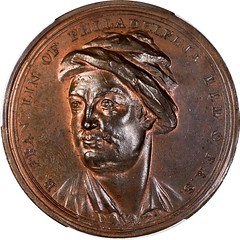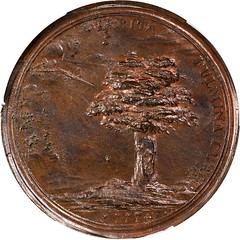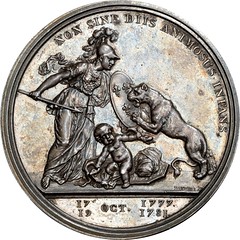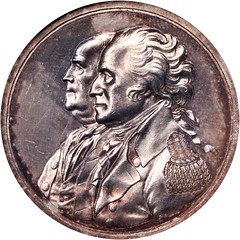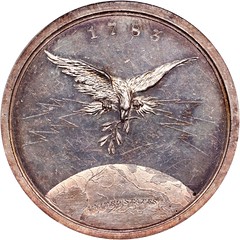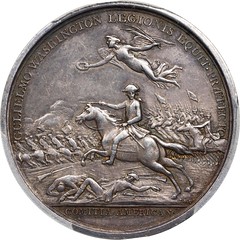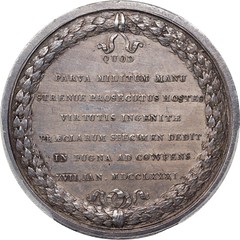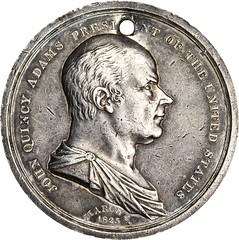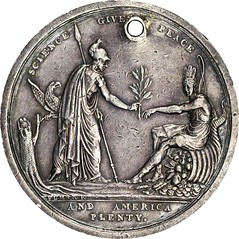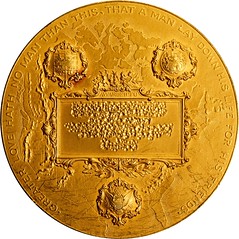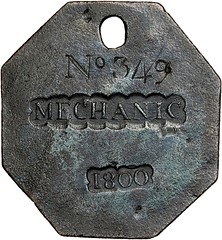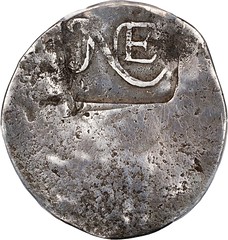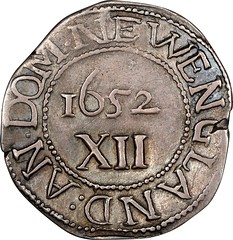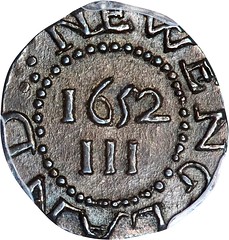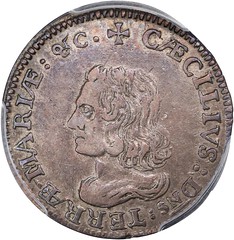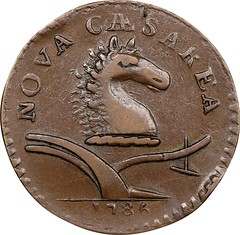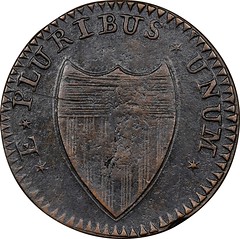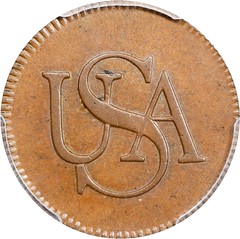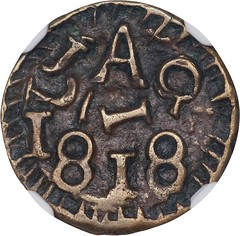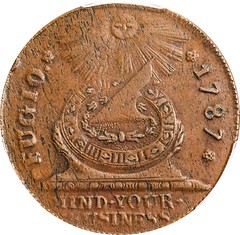
PREV ARTICLE
NEXT ARTICLE
FULL ISSUE
PREV FULL ISSUE
SBG NOVEMBER 2024 NUMISMATIC AMERICANAHere are some medal highlights in Stack's Bowers upcoming November 2024 Numismatic Americana & Early American Coins Showcase sale. Some great pieces here. -Editor 1777 B. Franklin of Philadelphia Medal. Unidentified English Medalist. Betts-547, Greenslet GM-40, Adams-Bentley 14. Bronze. Specimen-63 BN (PCGS). The origins of the 1777 B. Franklin of Philadelphia medal are obscure. The distinctive portrait, and the unusual basining of the reverse, bring to mind a group of medals that are clearly related: the 1778 Washington "Voltaire" medal, the 1777 Chevalier D'Eon medal, and the 1776 David Hume medal. Tony Lopez did a good job punchlinking this group in the June 2008 MCA Advisory, and finding that a group of medals shares a punchset is good evidence if not a slam dunk that they come from the same workshop. The August 2008 issue of the same journal features a detailed examination by English medal mensch Christopher Eimer, reflecting on the conversation he and Richard Margolis had shared years earlier discussing many of the same connections among these medals, while cautioning that little evidence connects these medals to the liberal-minded ceramics makers Wedgwood and Bentley. Provenance: Ex New Netherlands Coin Company, January 23, 1963; John J. Ford, Jr.; our (Stack's) sale of the John J. Ford, Jr. Collection, Part XIV, May 2006, lot 337.
To read the complete item description, see:
"1781" (1783) Libertas Americana Medal. Original. Paris Mint. By Augustin Dupre. Betts-615, Adams-Bentley 15. Silver. Thick Planchet. MS-61 (PCGS). No other medal in the canon of American numismatics is invested with so much history and importance as the Libertas Americana medal. It followed the declaration of American independence, whose date is placed in the obverse legend, and the support of France in the American cause. The two greatest American victories, that of Gates at Saratoga and Washington at Yorktown, are referenced with dates in the reverse exergue. The British armies defeated on those dates, Burgoyne's force at Saratoga and that of Cornwallis at Yorktown, are incorporated into the reverse allegory as the snakes strangled by Hercules in his crib. In that allegory, France is depicted as Minerva, defending the infant from the lioness, Great Britain, whose tail curls between her hind legs. The obverse design influenced many of the depictions of Liberty that would come from the first United States Mint, directly inspiring the Liberty Cap design found on copper half cents and cents in the 1790s. Dozens, perhaps hundreds, of later American medals and tokens used the design, from privately issued business cards to the United States Mint's 1945 Assay Commission medal. Its image was featured on contemporary engravings and textiles, and examples could be found in the 18th century in the collections of Thomas Jefferson, George Washington, John Adams, and more. No founding father is as closely associated with the medal, of course, as Benjamin Franklin. The medal was his brainchild and pet project, and every specimen that survives traces its provenance to him. Provenance: From the Bernardi Collection. Acquired by our consignor in 1981 shortly after discovery on a farm in the Amish community. This is its first known public offering.
To read the complete item description, see:
"1783" (ca. 1808) Washington / Franklin Treaty of Paris Sansom Medal. Betts-617, Musante GW-92, Baker-58, Greenslet GM-82, Julian CM-5. Silver. Specimen-62 (PCGS). This is the fourth and final entry in Joseph Sansom's series celebrating the History of the Revolution, the title he himself used on the case that held the three medals of the series he retained for himself (a set that we have had the pleasure of selling at auction intact more than once). The C.C.A.U.S. (Commander in Chief, Armies of the United States) medal was the first of the four, followed by the Presidency Relinquished medal, the Franklin / American Beaver medal, and finally, this one, issued at the end of the series in 1808. Unlike the bronzed copper specimens, silver examples do not appear to have been restruck. They are immensely historic, engraved by the talented John Reich, and rightfully prized by collectors to this day. Provenance: From our (Bowers and Merena's) sale of the David W. Dreyfuss Collection, April 1986, lot 5405.
To read the complete item description, see:
"1781" (ca. 1789) Lieutenant Colonel William Washington, Battle of the Cowpens Medal. Original. Paris Mint. By Pierre Simon DuVivier. Betts-594, Adams-Bentley 11. Silver. AU-53 (PCGS). When this piece is added to the three extant silver pieces that were accurately included in the Adams-Bentley census, it makes a total population of just four survivors, of which just three are in private hands. Remarkably, this is the third of those three to cross our podiums. It's more than possible that one of the two we've sold, or this one, was William Washington's own. Silver Comitia Americana medals are among the most powerfully desirable items in the realm of American numismatics. Distributed in tiny numbers to crowned heads and learned institutions of Europe, along with their Congressionally authorized recipient in this case, these original medals were not struck on spec or as collector items by the Paris Mint. Their production was intentional and their meager distribution was intentionally special, shepherded to completion by Founding Fathers like Benjamin Franklin, Thomas Jefferson, and William Short. No one will ever complete a set of Comitia Americana medals in silver, and even the most "common" of them are extraordinary rarities. Provenance: From Wayte Raymond's sale of the W.W.C. Wilson Collection, Part I, November 1925, lot 811.
To read the complete item description, see:
1825 John Quincy Adams Inaugural Medal. Julian PR-5, Neuzil-45. Silver. Very Fine, Holed. Michael Hodder commented in the description of the Ford piece that this medal was "undoubtedly, extremely rare in silver," and the fact that we have seen just two since, including this one, suggests he was quite correct. Our sale of the fabulous Garrett Collection included a silver specimen that had a prominent oxidation spot behind Adams' head and still realized nearly $10,000 all the way back in 1981. Other examples are in the collections of the Massachusetts Historical Society and the American Numismatic Society. Clearly, opportunities to acquire this medal in silver are precious few and very far between, regardless of grade.
To read the complete item description, see:
1869 New York State Agricultural Society Award Medal. Harkness-Ny 392, Julian AM-61. Gold. Specimen-63 (PCGS). Julian reports that the United States Mint did not receive the dies (two pairs) for this type until 1885, so the present example must be one of those specimens that the author states were struck prior to 1870 at private mints. Indeed, the dies for this type were prepared in the 1840s by William Joseph Taylor in Birmingham, England, using designs supplied by Francis Rotch, Esq., in fulfillment of an order placed by the Society. The latter received the dies, as well as the first medals struck, in 1845. This is only the second gold impression that we have offered in recent memory, and it is the counterpart to the specimen awarded to Walcott & Campbell in 1870 that realized $8,400 in our June 2024 Showcase Auction. It was also certified Specimen-63 by PCGS.
To read the complete item description, see:
(1913) Carnegie Hero Fund Medal. Gold. Awarded to Julius B. Gordon. Mint State, Engraving Effaced. While we have handled numerous bronze examples over the years, not surprisingly given their high distribution, our online archives back to 2009 include only three different silver examples, awarded in 1907, 1909 and 1920. This is the first gold award medal that we can recall offering, and it is a particularly intriguing specimen. While clearly an awarded example, the inscription to the recipient on the cartouche has been almost completely effaced by numerous tiny digs that, when viewed as a whole, provide a stippled effect to the surface in that area. Close inspection of the penultimate line in the inscription with a loupe, however, reveals traces of the following letters: ER CK OKLA. These are the letters for Frederick, Oklahoma. The third-to-last and penultimate gold Carnegie medals were awarded in 1913 to residents of Frederick, Oklahoma - Charles Zolninger and Julius B. Gordon - for helping to rescue Oliver H. Brewer and Alvah Dean from a cave-in in a well in that town on October 28, 1913. Zolninger and Gordon also received a money award. Two other men (William H. Reed, Sr. and John F. Steinbock) received silver medals and a sum of money for the same rescue.
To read the complete item description, see:
1800 Charleston Slave Hire Badge. Mechanic. No. 349. By Ralph Atmar. Copper. Very Fine. The 1800-dated tags are very distinctive within the Charleston slave tag series. They are the only tags made by Ralph Atmar and the only ones made in this small octagonal format. Known occupations of 1800 tags are House Servant, Porter, Fisher, and Mechanic. Out of the 146 tags in the National Museum of African American History and Culture collection, only five are from Atmar's 1800 emission: two Mechanics, two Fishers, and a House Servant. We've sold 1800 Porter No. 423 twice, once in January 2006 and later in the August 2023 Syd Martin sale, where it brought $6,600 despite being broken in half and backed. Heritage has sold a Porter (the same tag on two occasions), a Fisher, and a Mechanic. The 1800 Fisher No. 69 from the Jeff Pitts collection brought $20,700 in our (Bowers and Merena's) November 2001 sale.
To read the complete item description, see:
Undated (1652) NE Shilling. Noe 1-A, Salmon 1-B, W-40. Rarity-6+. VF-30 (PCGS). The NE shillings were struck between initial authorization on June 11, 1652 and the order to change the design on October 19, 1652, though it seems likely production continued after the legal decree of the new designs, at least until new dies were made and a press to use them was readied. There is no argument than the New England shillings were the first coins struck in what became the United States. Over the period of six months or so when these were produced, only the very rare Noe 1-D (four known) appears to have preceded this variety - and the die state of this specimen shows it was struck early among the Noe 1-As. While New England shillings are prime trophies for specialists in colonial coins, this primacy, historicity, and rarity makes collectors of all sorts desire these greatly. It's no wonder four of these are in museums in the United Kingdom, as they are of dramatic importance to collectors of British coins as well.
To read the complete item description, see:
Undated (1652) NE Threepence. Noe 1-A, Salmon 1-A, W-1. Rarity-8. EF-45 (PCGS). CMQ-X. The history of this coin is dramatic, important, and shared with other rare products made in Hull and Sanderson's mint after May 1652. The General Court of Massachusetts Bay established a mint for silver coins by terms of their Mint Act of May 26/27, 1652. Their choice for mintmaster, silversmith John Hull, memorialized his appointment in his diary: Upon occasion of much counterfeit coin brought in the country, and much loss accruing in that respect (and that did occasion a stoppage of trade), the General Court ordered a mint to be set up, and to coin it, bringing it to the sterling standard for fineness, and for weight every shilling to be three pennyweight; i.e., 9d at 5s per oz. And they made choice of me for that employment; and I chose my friend, Robert Sanderson, to be my partner, to which the Court consented. Hull was paid as a proportion of the coins he struck, and his mint would recoin any sort of silver that depositors supplied. In other words, a citizen of Boston could deliver other sorts of coins (including those that were worn out or counterfeit, as long as they were silver), flatware, hollowware, or anything else, and Hull would return to them coins of good, properly assayed silver minus a small percentage (6.5%) to pay for Hull's expenses and a smaller percentage (1.25%) to cover silver lost in the assaying process. The 8% charges allowed every Massachusetts citizen to turn their unwanted silver or unspendable coins into easy, ready cash. The primary effort Hull exerted was in the assaying process, which required significant expertise, acquisition of chemicals and equipment, and careful attention to the work. Coining the coins was relatively easy: silver sheet was clipped down to proper size and weight, and two stamps were applied. The stamp for the obverse was a simple NE hallmark, representing New England, and the stamp for the reverse denoted the denomination: XII for shillings (12 pence), VI for a sixpence, and III for a threepence. The same amount of work was required for each coin, regardless of denomination. It is not hard to imagine why NE shillings are more numerous than NE sixpence or NE threepence. Provenance: From the Janssen Sastra Collection. Discovered in the Netherlands in 2016.
To read the complete item description, see:
1652 Oak Tree Shilling. Noe-1, Salmon 1-A, W-430. Rarity-3. IN at Left. AU-50 (PCGS). Very typical centering for a Noe-1 Oak Tree. Most obverse letters run to the edge, although the reverse is better centered. Clear outlines of the reverse die edge visible at top and bottom, none on obverse. This coin is evidence that the obverse die was broader than the reverse because when it was trimmed at the mint it lost some of its outer design. Edge ragged at right on obverse, as made. Obvious S bend, as made, but without any elongation to the letters. No reverse die break through the tops of the letters in NEW, and so an earlier state of these dies. The collector seeking a single Oak Tree shilling would be wise to give this piece serious consideration. Provenance: From the Ross Family Collection. Earlier ex S.H. & H. Chapman's sale of the Harlan P. Smith Collection, May 1906, lot 4; S.H. Chapman's sale of the William Gable Collection, May 1914, lot 149; Stack's, May 12, 1987, privately to the following; our (Stack's) sale of the Hain Family Collection of Massachusetts Silver Coins, January 2002, lot 13.
To read the complete item description, see:
1652 Pine Tree Threepence. Noe-37, Salmon 2a-B, W-640. Rarity-5. Without Pellets at Trunk. MS-61 (PCGS). When Walter Breen cataloged the grounder Kendall coin in its earlier appearance in Superior's 1974 Ruby sale, he called it "unquestionably above average condition for the variety," which, while perhaps not true, points out that most examples from these dies have not survived in tip-top shape. Partrick's coin, ex Hain, was certainly exceptional - it sold in Heritage's January 2015 Signature Auction certified NGC/CAC AU-53. Syd Martin's was unexceptional in a PCGS Fine Details holder due to damage, and a perusal of our archives shows that most others that we have offered in the last couple decades have been impaired for one reason or another. The Boyd-Ford specimen offered here is in a category all its own - far and away the finest that we have seen from these dies, and a coin that would serve as a leading highlight in any cabinet. Provenance: Ex F.C.C. Boyd; John J. Ford, Jr.; our (Stack's) sale of the John J. Ford, Jr. Collection, Part XII, October 2005, lot 147. The plate coin for the Noe-37 dies in the 2010 Salmon reference on Massachusetts Bay Colony silver coinage, pp. 232-233.
To read the complete item description, see:
Undated (1659) Lord Baltimore Sixpence. Hodder 2-C, W-1060. Rarity-5. Small Bust, No Stop. Silver. EF-45 (PCGS). Choice and original Lord Baltimore sixpence such as this are highly elusive, a fact that the discovery of 19 pieces in a single English hoard in 2002 did little to change. Few of those pieces showed this kind of strike, most were wiped or cleaned, and none showed this sort of richly original toning. At least one example of this type has been recovered in the ground in North America (in southern Virginia), and many are well circulated, definitive proof that this type achieved its purpose of colonial American circulation in the 17th century. Provenance: From the Ross Family Collection. Earlier from Heritage's Atlanta, George Signature Sale of August 2001, lot 5015.
To read the complete item description, see:
1785 Connecticut Copper. Miller 3.1-F.3, W-2320. Rarity-6+. Bust Right. EF-40 (PCGS). One of several significant Connecticut coppers we are offering in this sale, and a standout example of this elusive and challenging Miller number. The letters AUCTO on the obverse and DE on the reverse are not struck up, quite probably due to axial misalignment of the dies. Where the original surface of the coin can be seen (above the effigy's head and in the right obverse field, in particular), the detail and level of preservation are solidly EF. Obverse slightly striated diagonally from 12 o'clock to 6:30, surface rough at the letters NN in CONNEC, incomplete clip and edge burr outside the final C. Reverse more heavily striated, right portion with two near parallel linear flaws, center with light scratches and further stray flaws, another linear flaw runs from the seated figure's hand to the base of the letter N in INDE. The census for this variety has crept up to about 14 coins in recent years, but this remains the finest known. It is better than the Perkins duplicate, ex Norweb, the ANS and both CNL coins, as well as Taylor:2299. Both the Oechsner and Ford collections were missing this Miller number entirely. Provenance: Ex Colonial Trading Company, January 1995; our (Stack's) sale of the George C. Perkins, Esq. Collection, January 2000, lot 188; Jon Hanson, January 12, 2000; Donald G. Partrick; Heritage's sale of the Donald G. Partrick Collection of Connecticut Coppers, November 2020, lot 44005, as NGC EF-40 BN, and accompanied by NGC insert #2048943-005 from that earlier certification.
To read the complete item description, see:
1786 Connecticut Copper. Miller 5.11-S, W-Unlisted. Unique. Mailed Bust Left, Sword Hilt and Guard Reverse. VG-10 (PCGS). Stack's Bowers Galleries is pleased to present the unique Miller 5.11-S, the first new 1786 Connecticut copper variety discovered since 2008. This exciting coin pairs two previously known dies in the Connecticut copper series. Obverse 5.11 was previously known only in the 5.11-R pairing, while reverse S was previously known paired with obverses 4.2, 5.14, and 5.15. With four known pairings, reverse S is now tied with reverse G as the most prolific reverse among 1786 varieties. When this coin surfaced on the first day of the January 2023 FUN Convention, it became the first new 1786 variety discovered since 2008, when 4.1-H.2 was identified. Since there are now two specimens known for 4.1-H.2, 5.11-S is currently the only unique die pairing among 1786 Connecticut coppers. This is its first auction appearance - an opportunity that represents what will very likely be a once in a lifetime bidding opportunity for the collector striving to complete a set of all 357 confirmed Connecticut copper varieties. Only the most aggressive bidding strategy will prevail here. Provenance: Discovered at the January 2023 FUN Convention.
To read the complete item description, see:
1786 New Jersey Copper. Maris 12-G, W-4790. Rarity-4. Date Under Plow, No Coulter, Shaggy Mane. EF-45 (PCGS). There are a fair number of Maris 12-Gs around, certainly more than most of the No Coulter combos, and at least a handful of them are pretty nice. The Spiro-Oechsner coin is ranked number one, followed by a small number of EFs, which listing needs to include this one. The Syd Martin coin is ranked fifth in the Siboni-Howes-Ish census, and it realized $44,400 in our Summer 2022 Global Showcase Auction, due no doubt in part to the notation in our description that "your cataloger would rank it above at least two of those ranked at higher positions based upon its various levels of appeal and near perfection for the grade." This coin is nearly the equal to the Martin coin in most respects, and is worthy of the strong bids. Provenance: From the Ross Family Collection. Earlier from McCawley-Grellman's Ninth Annual C-4 Convention Sale, November 2003, lot 385.
To read the complete item description, see:
1788 New Jersey Copper. Maris 50-f, W-5475. Rarity-3. Head Left. EF-40 (PCGS). Obverse die swell in right field, as usual for the variety, subsidiary break through the letters REA in CAESAREA to the left plow handle, reaching to date. Reverse die perfect. This is a popular Maris number for type purposes, but with the quality offered here it is quite rare. Ranked No. 8 in the 2013 Siboni-Howes-Ish Condition Census, and also the plate coin for these dies in that reference. Provenance: From the Ross Family Collection. Earlier ex Henry Chapman's sale of the George M. Parsons Collection, June 1914, lot 271; Hillyer C. Ryder; F.C.C. Boyd; our (Bowers and Merena's) Frontenac Sale, November 1991, lot 185. The plate coin for the Maris 50-f dies in the 2013 Siboni-Howes-Ish reference on New Jersey coppers, p. 404.
To read the complete item description, see:
Undated (ca. 1785) Bar Copper. W-8520. Rarity-4. MS-62 BN (PCGS). The Bar copper is perhaps the early American coin best equipped to illustrate two great narratives of the Revolutionary-era: the military struggle for independence and the economic struggle against crummy coppers. Both the obverse and reverse designs of the Bar coppers were borrowed directly from buttons worn by Continental Army soldiers. The obverse design was commonplace throughout the war on the coats and vests of soldiers from New England to the Carolinas, making this design instantly familiar to most who encountered it. The lifespan of those buttons was longer than the circulation life of a Bar copper, however. The Bar coppers did meet with initial success in the young United States, where a dearth of circulating specie meant that they were eagerly accepted in commerce. At the time of their introduction, however, these coins were among the most underweight of the post-Revolutionary coppers, sometimes weighing as little as half of a Fugio cent. When the Copper Panic of 1789 hit New York, the Hudson Valley, Philadelphia, New Haven, and Boston, these were among the first coppers to be tossed from circulation, which is why AU Bar coppers are more common than VGs. Those AU coins vary widely in quality though and, of course, true Mint State pieces such as this are noteworthy rarities. This is certainly one of the nicest to come on the market in recent years.
To read the complete item description, see:
1818 New Spain (Texas) Jola Token, or 1/2 Real. W-8540. Small Planchet. EF-45 BN (NGC). Interestingly for such a rare issue, there are several known die varieties of the 1818 jolas. All examples bear the same basic design, which is virtually identical to that used to produce Barrera's 1817 coinage. The obverse exhibits the initials of the issuer (for the 1818 coins J.A.G.) above, the fractional denomination 1/2 (for 1/2 real, oriented sideways) in the middle and the date below. The reverse design is very simple with the five pointed Lone Star of Texas stamped into the planchet. A small raised dot is present near the center of the star. The jolas of 1817 and 1818 are believed to represent the earliest use of the Lone Star symbol of Texas. The De la Garza coinage of 1818 is also known on both small and large size planchets. Provenance: From the Ross Family Collection. Earlier from our (Bowers and Merena's) ANA Sale of the Millennium, August 2000, lot 181. There are many great rarities in this group, but this lot particularly stands out to me. I've seen fakes, but never held a real one in my hand. Important relic of numismatic history. Are there more examples out there waiting to be discovered? -Editor
To read the complete item description, see:
1787 Fugio Cent. Pointed Rays. Newman 9-S, W-6765. Rarity-6. STATES UNITED, 4 Cinquefoils. AU-53 (PCGS). Exceptional quality for this rare and conditionally challenging Newman number. The 9-S die pairing was not known to Newman in his original 1949 article on the "Varieties of the Fugio Cent," and though it has dropped in rarity from R-7+ in the early 1980s to a solid R-6 today, it remains difficult to find an example, much less a decent one. There are fewer than a dozen appearances in our archives for the last 20 or so years, some of which are for the same coin. Mos of those were VF-20 or less, one was a PCGS AU-50. The offered coin is not included in the 2016 Retz census, but based on its certified grade and overall quality it is comfortably within the Condition Census. Provenance: Ex Heritage's sale of the Oak Collection of American Colonial Coinage, September 2005 Long Beach Signature Auction, lot 503; Kevin Vinton, August 17, 2018.
To read the complete item description, see:
To read the earlier E-Sylum article, see:
Wayne Homren, Editor The Numismatic Bibliomania Society is a non-profit organization promoting numismatic literature. See our web site at coinbooks.org. To submit items for publication in The E-Sylum, write to the Editor at this address: whomren@gmail.com To subscribe go to: https://my.binhost.com/lists/listinfo/esylum All Rights Reserved. NBS Home Page Contact the NBS webmaster 
|
